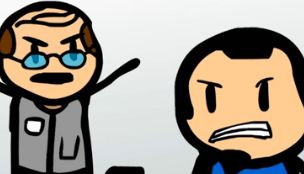Team Conflict and the Work Process
After you watch the video and know the material, click HERE for the quiz.
Conflict is inevitable in groups, which is why managers must understand it. In this lesson you will learn about the reasons why teams may encounter conflict while working together.
Conflict in Teams
Conflict is one of those words that can stir up a good deal of emotion; we hear 'conflict' and immediately think about disagreement. Perhaps that is why most people try to avoid it. However, not all disagreement is bad, especially in a group or team setting.
Conflict in a group tends to signify a variety of opinions, insights and ideas, which almost always leads to better decision making in the long run. In fact, a major advantage a team has over an individual is its diversity of resources, knowledge and ideas. A group where everyone agrees with one another, shares the same resources or knows the same information has little to discuss and thus little to contribute.
 |
Where Conflict Comes From
Conflict occurs in groups due to differences, especially in close quarters such as workplaces. Because no two people are the same, these differences will surface over time and cause conflict.
The reason our differences cause conflicts is because of how we view the world and how we interpret the behavior of others. Each individual team member will hold their own unique perceptual set of beliefs, values and attitudes about the world around them. They walk around interpreting everything they see or hear through this perceptual set, and when two people's perceptual sets do not match (and they often don't) conflict happens.
For example, let's say Marco, who is a very sociable and open person, is working with Peter on a project for work. Marco quickly shares his ideas on what he thinks is the best action to take, but Peter is quiet and provides very little input during the brainstorming session; if anything, he disagrees with Marco's ideas. Marco, being someone who is very sociable, might interpret Peter's lack of participation as Peter's displeasure with having to work with Marco. Now that Marco believes that Peter does not like him, Marco decides that he does not like Peter and thus, conflict occurs.
 |
People Conflict
Conflict can arise from numerous sources within a team setting and generally falls into two categories: people-centered or task-centered. People conflict, sometimes referred to as relationship conflict, involves interpersonal conflict between the people of a group. People conflict occurs when two people disagree with one another and make it personal.
As I mentioned earlier, when two people disagree, it can lead to greater decision making by fostering debate and allowing all issues and solutions to be fully examined. When two people quickly agree with one another, these issues and solutions can be easily overlooked. However, in order for that disagreement to be a productive conflict, the two parties must remain focused on the issue about which they disagree. Once the individuals themselves become the center of the conflict and not the issues, people conflict occurs.
 |
One major cause for people conflict is the perceived inequality among team members or when one member is treated unfairly. The group's leader must take immediate action whenever people conflict occurs to minimize its negative effects on the team. This would involve making sure that everyone has equal access to information and resources they need to carry out their group's task, reminding the group of their purpose, promoting group cohesion, encouraging teamwork and fostering a professional work environment.
Task Conflict
The second type of conflict that occurs in groups is task-centered. Task-centered conflict is just that, conflict that is focused around the task at hand and involves disagreements among the group members about group goals and the tasks being performed.
Because we all have our own view of the world, we also have our own opinions, views and ideas about the group's goals, what solutions might work and how group tasks should be completed. For example, let's say Marco believed that the best course of action on the project was to increase the amount of advertisements being made in a specific region, whereas Peter felt that a new branding campaign would better solve the problem they were working on. Marco and Peter are experiencing task conflict over what the best course of action to take on the project is.
 |
There are often several ways to solve a problem, and without conflict, those solutions could go unexplored. While group members can experience conflict over things, such as which solution to choose and what members should complete which tasks with little consequence, conflict over the team's goal can be a significant problem. It is imperative that group members clearly understand what their goal is; otherwise, confusion and frustration can set in. When a group does not understand their purpose, they can't even begin to work as a team. For this reason group clarity must be established and understood early on by all members of the group.
Group leaders that witness task conflict in their groups can take a far more hands-off approach to resolution than people-centered conflict. In many cases leaders can just allow the members to solve their issues on their own. For Marco and Peter, while they may continue to dislike one another due to their people-centered conflict, they can quickly solve their disagreement about which solution to implement by weighing out the pros and cons of both.
 |
Lesson Summary
Let's review. Conflict occurs in groups due to differences. The reason our differences cause conflict is because of how we view the world and how we interpret the behaviors of others. Each individual team member will hold his or her own unique perceptual set of beliefs, values and attitudes about the world around them. When group members' perceptual sets do not match, there is conflict. The trick to fostering effective conflict in teams is being aware of our perceptions and learning to appreciate our differences.
Conflict in groups can be people-centered, task-centered or both. People conflict, sometimes referred to as relationship conflict, occurs when two people disagree with one another and make it personal. Because people conflict is so emotionally charged, it can be extremely difficult to manage and thus very harmful to the group. This makes it necessary to take immediate action to find a solution.
Task-centered conflict is focused around the task at hand and involves disagreements among the group members about group goals and the tasks being performed. Group leaders can take a far more hands-off approach to solving task conflict, many times allowing members to solve their issues on their own.